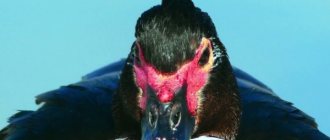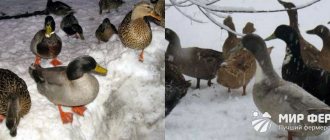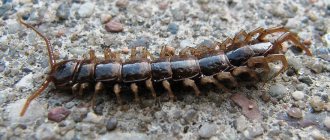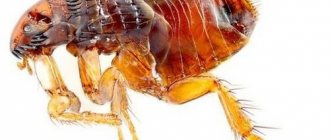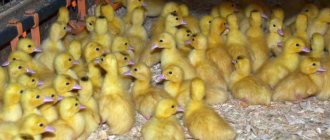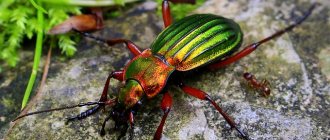1 592
no comments yet
1
Author:
Rasskazov Pavel.
Reading time: 1 minute
The ideal option is for farm birds to live separately, however, often the need to keep chickens, ducks and geese together is caused by lack of space. Ducks, due to their phlegmatic and peaceful nature, can easily get along with chickens. Geese, by their nature, are very aggressive and keeping them with chickens is problematic, but it is still possible.
Features of the behavior of chickens, geese and ducks
To keep them together, an extensive walk is necessary so that the birds can each browse the grass in their own corner. If goslings, ducklings and chicks grew up together, then in the sexually mature state they do not conflict.
However, when adults are released onto the pasture, the geese begin to establish their own order. Ducks are on the second rung of the hierarchy, with chickens taking the last place.
Over time, certain relationships are established in which the birds behave peacefully if they comply with the rules of hierarchical subordination.
Geese dine first, then chickens
However, when grazing, chickens, geese and ducks quickly destroy all the grass. Birds need to be fed, and a room must be equipped for them.
When a poultry farmer wants to have chickens, ducks and geese, and the size of his plot does not allow him to build separate rooms for different types of birds, he decides to keep them all under one roof.
Rules for caring for poultry
Laying hens and broilers are the most common representatives of birds. They do not require special conditions or close care. The main preconditions for effective rearing are balanced feed and regular cleaning of the barn or cages. Chickens need dry bedding, no drafts, good lighting, and cannot tolerate excess moisture. Broilers are also sensitive to temperature changes and diseases.
It is recommended to keep meat breeds in cages or in a small fenced area - they move little, eat well, which contributes to effective weight gain. The best option for chickens is combined keeping in the chicken coop and on the run.
The habitats of chickens should be provided with feeders, drinking bowls, and nests.
Advice. Chickens love to bathe in ash - it helps them clean their feathers and get rid of parasites. You need to pay attention to this and install a container with ash in the area where the birds are kept.
Chickens are very unpretentious in food, but prefer combined feed from grain crops, succulent feed, and root crops.
Geese and ducks are waterfowl and need water. In this case, it is possible to keep them in a closed or semi-closed way. Most breeds gain weight very well - in 2-3 months you can get a livestock weighing 4-5 kg.
To reduce the cost of feed and improve the well-being of birds, it is recommended to combine keeping in a barn with the possibility of walking.
It is worth considering that ducks love to swim - this is how they clean their feathers and nasal passages. In the absence of natural reservoirs, reservoirs with water and gravel should be placed in the habitat - this is needed for better absorption of food.
Unlike ducks, geese prefer to graze: they love meadows and large pastures. If it is possible to release birds into open space, this can significantly reduce the cost of feeding them and improve their well-being.
Poultry care
Infectious diseases common to chickens and waterfowl
Birds of different species graze separately from each other.
Chickens, ducks, and geese can transmit infectious diseases to each other. In addition to the common infections that cause pasteurellosis or salmonellosis, there are those that are transmitted by carriers to susceptible birds.
Thus, the virus of Newcastle disease (Asian plague) is transmitted to chickens by geese, as well as by ducks, which themselves do not get sick. Chickens infect ducklings with Marek's disease viruses, as well as avian influenza. However, the greatest danger lies in keeping birds of the same species of different ages together.
Be sure to read:
Common diseases of ducks: why do ducklings roll over on their backs and twitch their paws?
In adults, the disease is asymptomatic or mild, and young animals can die. Therefore, for birds of different species and ages, it is advisable to place them in different sections, even under one roof.
Characteristics of appearance
Chicken geese are endemic - birds that live in a limited area with a small geographic area. Indeed, the habitat of these birds is small: the island of Tasmania and the southern coast of Australia.
The chicken goose cannot be confused with other representatives of the Australian and Tasmanian fauna. The powerful bird reaches a meter in height. Weight can vary from 3 to almost 7 kilograms. There are other distinctive appearance features:
- the base color of the plumage is light gray;
- the tips of the tail and wings are emphasized by black feathers;
- black and white streaks are scattered on the wings;
- on a small head there is a white cap;
- short beak, black below, curved tip, reminiscent of a chicken (another detail for which the species received its name);
- short neck;
- wide chest;
- bright red strong legs, the color of which from the tarsus and below turns black;
- small membranes between the fingers.
Features of Shared Content
Keeping waterfowl in the same room as chickens is undesirable for the following reasons:
- Ducks and geese need a water bath, they splash around in it, so the room is damp. Chickens need a dry ash bath in which they are freed from parasites.
- Egg-laying hens require bright lighting and adjustable day length. Ducks and geese become aggressive in bright light. Therefore, the premises must be isolated. If a farmer has Muscovy ducks, it is better to keep them with chickens rather than other types or breeds of ducks.
- Waterfowl are kept on permanent bedding; as it becomes saturated with sewage, a new layer is applied. Chickens need dry bedding, which is replaced with clean bedding from time to time.
- Chickens like to rest and lay eggs in high places. Ducks and geese - in a secluded place on the floor. Therefore, some kind of booths are equipped for them.
Despite the fact that the birds are isolated from each other, pathogens can pass from one compartment to another through sneezing and air movement.
Newcastle disease in chickens.
Therefore, a separate room should be provided for sick birds, which makes it difficult to keep different types of birds under one roof. When kept together, the risk of transmitting infectious diseases from one type of bird to another increases.
Captivity
Recently, the chicken goose has begun to appear in private yards as a pet. But attempts at domestication rarely end in success - the bird often conflicts with other birds, attacks its owner, and flies over fences.
In order for geese to like captivity, they need:
- a fenced paddock of more than 200 m2 with lush vegetation;
- a house with a roof where the geese can hide in bad weather;
- heated poultry house in winter (per bird - 1 m2);
- a body of water that stimulates reproduction;
- a thick layer of hay as bedding and feed (it must be periodically added and renewed as it gets dirty);
- additional complementary foods: fresh vegetables and fruits, animal feed, wheat, worms, insects, shellfish.
We hope you found the article interesting. In the comments you can share your impressions of what you read. We will be grateful for your like and repost.
Features of joint feeding
To avoid conflicts during feeding, each species of bird is fed in a separate enclosure.
The birds are fed separately, each species in its own compartment. However, when walking in a common yard, feeders and drinking bowls are installed. To avoid water splashing, nipple drinkers are installed.
A mesh partition is installed over the feeders to prevent birds from scattering food. Geese feed first. Once satiated, they do not mind approaching duck feeders. The chickens eat last.
Be sure to read:
What to do and how to increase hatchability when incubating Muscovy duck eggs
The disadvantage of this approach is that the diet is unbalanced: the nutritional needs of birds of the same species are not the same.
Dignity is the pleasure gained from watching waterfowl and chickens pecking from the same feeder.
Conservation status
The number of chicken geese is small - about 8 thousand heads. However, there is no threat of extinction.
There were stages in the history of the species when it could have disappeared from our planet, but timely measures taken made it possible to stabilize the situation and preserve the population.
People killed chicken geese for meat and fun. But in the 20th century, Australian authorities passed a law prohibiting the destruction of these birds.
The chicken goose came to Eurasia at the end of the 20th century. It was from those times that the species became a permanent resident and decoration of zoos in Europe.
If treated well, birds can breed in captivity. Conservationists are taking care of their pets, trying to increase their numbers.
Advantages and Disadvantages of Shared Content
The main advantage is saving space, building materials and equipment. All sections are located under a common roof, air exchange is carried out by a common ventilation system. Shared content has more disadvantages.
The main disadvantages of combined content are as follows:
- Dampness in the waterfowl sections extends into the chicken area. Discomfort increases the risk of respiratory diseases.
- Wet litter decomposes, the accumulating gases hurt the eyes of the poultry farmer and cause eye damage in chickens - the so-called ammonia blindness.
- The need to regulate ventilation, provide different light modes for chickens and waterfowl.
- High labor costs when caring for poultry.
- Increased risk of infection of chickens from waterfowl and vice versa.
Origin
The chicken goose is very rare in nature. It is unique and listed in the Red Book. Belongs to the duck family, order Anseriformes.
South Australia is the home of this large, beautiful goose. Researchers discovered such an amazing bird on Cape Island. The remains of flightless geese of the genus Cnemiornis were found on the island of New Zealand.
There is an assumption that these are the remains of the ancestors of the modern chicken goose. Therefore, it was first called the New Zealand-Cape Barren goose. However, this opinion was wrong. Then the mistake was corrected and they were described as a subspecies, Cereopsis novaehollandiae grisea B. They got their name from a group of islands called the Recherche archipelago.
Ostriches - for wealthy farmers
An ostrich farm is a great business idea, but it requires substantial and “long” financial investments. Everything from the ostrich is sold and used - the famously large eggs, tasty meat, feathers, and even skin. But you will have to devote a lot of time to the exotic farm, and it will bring the first income no earlier than the third year. Will you wait?
Rich people sometimes raise ostriches for personal use. But it should be remembered that a large bird, in any case, needs a large territory with a reliable and durable fence.
Ostriches are somewhat similar to horses - they love to run and are sometimes aggressive, especially the males. It is better not to let children near them unattended.
In general, the ostrich is not a dacha poultry for beginners . Even if an ostrich farm is your lifelong dream, first practice on cats (just kidding). That is, first take a brood of chickens or another type of bird, as common in villages as domestic cats.
Learn poultry farming from scratch, just like learning a foreign language. First - a primer and simple stories, and only then - “Shakespeare in the original”.
Differences between duck and goose food
It is impossible to say that there is much difference between duck and goose food. Both types of poultry are fed grain, mixed feed, vegetables, grass and hay. Young individuals are released into the meadow at an early age. Birds readily eat grass, worms and insects.
If there is a pond or river with a small current near the site, it will be very profitable to feed waterfowl. Already at the age of 2-3 weeks, the bird is driven to the water, where it finds food for itself. Pets should be fed grain only in the evening.
Important
Not every summer resident has the courage to kill a chicken for soup on his own. In this case, you will need someone's help. Think in advance who you will contact. If you are a weak-hearted and compassionate person, it may be better to buy meat at the store.
A feather pillow is also easier to buy for money. Firstly, to fill it you need a lot of down and feathers: a couple of laying hens will not be able to provide so much material. Secondly, turning “raw” feathers into safe, soft and comfortable stuffing with a long shelf life is not an easy task. Not every handmade fan can handle it.
Handle poultry with care. Frightened birds may peck or pinch painfully. Most often, males display defensive aggression, especially if they have a “harem” of females. Don't let children tease roosters, geese and drakes.
Chickens are a classic
Breeders have developed so many different breeds of chickens that you need to understand them at least a little so as not to be disappointed in the very idea of poultry farming. Chickens of egg breeds have rough, tough meat; meat breeds rarely lay eggs. In addition, if you visit your dacha only in the warm season, you need to choose “short-lived” birds. Many breeds of egg-laying chickens start laying eggs at 7-8 months of age and will not be suitable for you.
The gold standard of poultry farming is broilers. It is from them that the chilled semi-finished products so beloved by the townspeople are made. Typically, broilers are slaughtered at about 40 days of age, so over the summer you can raise as many as two generations. If you want to get large carcasses of 2.5-3 kilos, fatten the broiler for three months. But then its meat will be less tender than that of 1.5 month old chickens.
Meat-egg chickens are the choice for a country house with year-round use. While they are growing, they will have time to please you with homemade eggs. And then you can score. There are also decorative chickens, you can only admire them. Their eggs are small, the clutch is sparse, the meat is tough and tasteless. But the plumage is beautiful!
Indian's wife
Turkey contains only 60 kcal per 100 grams and almost no fat. In addition, there is practically no harmful cholesterol in it, so lovers of this bird are not at risk of vascular plaques and heart attacks. Turkey can rival fish in phosphorus content, so you are guaranteed a sharp mind and strong teeth. Turkey is also the only type of meat that does not cause allergies, so it is often included in children's menus. Due to its low fat content, turkey often turns out a little dry, so it's best to season it with gravy. But you can’t make turkey soup—this bird won’t provide a rich broth.
Who is this game?
Game - goose
Initially, any animal that was hunted (and not just birds) was called game. This is also the name given to the meat of these animals. “game” itself comes from the word “wild” . There are a huge number of animals that can be hunted for food.
Nowadays game refers to ducks, geese and other birds that are fattened for food. Initially, people hunted them, and therefore the word “game” became widely known.
Calculation data
The number of ducklings is 40 mulard ducklings, 10 Bashkir ducklings. They were purchased at the state incubation station in the Lipetsk region, at a price of 182 rubles per mulard, and 88 for a “Bashkir” at five days of age on May 13, 2019. The acquisition costs amounted to 6,560 rubles. The cost of the road was not taken into account, since the ducklings were purchased along with the feed.
Slaughter was carried out after 70 days for 10 days, i.e. ducks were kept until the beginning of August.
The ducks were fed during the first month with industrially produced compound feed PK-6 from the Istrinsky bakery, at a price of 1,070 rubles per 40 kg bag. In total, 7 bags worth 7,490 rubles were spent. Wheat and corn were spent in 2 bags of 40 kg each, wheat - 16 rubles per kg, corn - 25 rubles per kg, a total of 3280 rubles.
Feeding from 31 days until the moment of slaughter was carried out with wet mash based on last year's sprouted potatoes from our own harvest, grass, leftover food from the kitchen, sprouted wheat (leftovers purchased earlier).
Additionally, two bunker feeders for waterfowl were purchased for 480 rubles each for a total of 960 rubles. To roast the carcasses and heat the water for scalding, a 27-liter gas cylinder for 580 rubles was almost completely used up.
Total costs amounted to 18,870 rubles.
The average weight of a plucked and gutted carcass was 3,200 grams. At a price of 450 rubles, whole carcasses immediately after slaughter, 22 ducks were sold for a total amount of 31,680 rubles. There was no need to look for clients; neighbors at the dacha, who regularly purchased chicken eggs, took their children and grandchildren to the “petting” zoo all summer. My work acquaintances also happily purchased one or two ducks each for the holiday.
The remaining 28 ducks were distributed as follows - 10 ducks with a total weight of 30 kg were frozen until the New Year, when they will be sold to the same clients at a price of 500 rubles per kg. (We have a sufficient amount of freezers; urban clients have limited freezer space). The proceeds will be approximately 15,000 rubles. The remaining 18 ducks were cut into breasts, which were frozen and home-made stew. These products are intended for personal use.
The profit on the project is 27,810 rubles expressed in real money. Indirect income can be considered approximately 70 half-liter cans of homemade stew, and about 10 kg of gourmet meat.
Breeding conditions
For the most part, the chicken goose prefers land and walking rather than flying or swimming. A negative attitude towards bodies of water does not prevent birds from raising their chicks near the water. When this crucial moment comes, the geese retire as a pair. The rest of the time they live with everyone else in the flock. They feed on lush grass where they graze.
Before mating occurs, the male performs a beautiful mating dance. The nest is made directly on the grass or in open areas, or in rocks. The inside of the nest is lined with soft down and feathers. The female lays 4-5 eggs. The eggshell is smooth and whitish-yellowish in color. Married couples are formed once and for life. But if for some reason a misfortune occurs and one of the spouses dies, then the remaining spouse again forms a family with a single bird.
The incubation period for eggs lasts approximately 5 weeks. From the moment of birth, chicks are always near their mother. During this period, dad diligently protects his family. Shows excessive aggressiveness towards others.
Chicken Ryaba
In terms of protein content, the chicken is ahead of all the inhabitants of the poultry house. In addition, chicken protein contains more essential amino acids, which are responsible for protecting our body from viruses and infections, and at the same time for tissue renewal. In addition, chicken is full of microelements: zinc (needed for beautiful skin, thick hair and long nails), magnesium (helps build muscles), copper (necessary for good heart function and strong immunity). Another advantage of chicken is its ability to “get along” with almost any food. It goes well with all known side dishes, feels good in soups and broths, and can be topped with exotic sauces made from mango, pineapple or cranberry.
However, there is still a fly in the ointment. The fact is that the carcasses that end up on our store shelves are, as a rule, generously stuffed with antibiotics. And when you regularly supply your body with even microscopic doses of medicine, it gradually gets used to it. As a result, if you get sick, antibiotics won't help you. Another danger that lies in the chicken carcass is steroids. They feed the bird so that it grows big and fat. So, if a person eats chicken pumped with hormones, he most likely will not become big, but he will easily become fat. Therefore, when choosing a chicken, do not chase the size. If a bird manages to reach the size of an average goose, it couldn't have happened without steroids.
Well, the most “terrible” representatives of the chicken family are grilled chickens. Firstly, in the tents where they are prepared, basic hygiene rules are not observed. And secondly, while the chicken is spinning on a spit, carcinogens accumulate in it. It is believed that these substances can cause malignant tumors. The only consolation for grilled chicken lovers is its very low fat content. During spit roasting, the fat simply flows out of the carcasses.
Tips for beginners
The chicks that have just emerged from the eggs are still weak and cannot maintain their body temperature on their own. That is why mother hens keep them warm by collecting them under their wings. You bought day-old chicks (turkey poults, goslings, etc.) - become a hen yourself. No, you won't have to carry your chicks under your robe like a hen (just kidding). Just place your kids in a box, which you place next to a radiator or under an electric light bulb.
Attention! Not all models of energy-saving lamps produce heat. If the light bulb does not heat up, the chicks under it will freeze. You can use hot water bottles as an imitation of “mother’s warm side,” but they will have to be changed very often.
The best food for day-old chicks is a finely chopped boiled egg. The pieces will have to be rolled in semolina so that they do not stick together. A day later, cottage cheese and finely chopped greens are introduced. Children are given water with potassium permanganate, very diluted to a pale pink hue.
For the first weeks, the babies live separately, and only at the age of 60 days can they be transferred to the poultry house. Until then, it is necessary to harden the chicks. They harden themselves with walks on warm days - in the garden or in the yard. Start with 15 minutes a day and gradually increase to 2 hours. But be careful! If the birds are clinging to each other, it means they are cold and it’s time to go home.
What kind of poultry at the dacha did you find interesting? Share your opinion in the comments.
Good luck!
Subscribe to site updates and our channel “Chicken” in Yandex.
See you later, colleagues! In the meantime, we will prepare new and interesting information for you!
Did you like our tips? Share with friends on social media. networks!
Duck hunting
About a third of a duck carcass is fat, another third is bones. But the rest is meat with a noble bitterness and piquant aroma. Compared to chicken, duck has more vitamin A, but this does not mean that duck can be a worthy replacement for chicken in your menu. Duck also contains more than enough bad cholesterol, so this bird should be perceived as a delicacy rather than as an everyday dish.
Duck meat is quite tough; the best way to cook it is to stew it or bake it in the oven. Duck is good in combination with something sour, so feel free to stuff it with apples, cherries or dried apricots. Choosing a duck is a delicate matter. And it all depends on what you value more. If the main thing for you is that the meat is soft, choose a smaller carcass with light skin. These signs indicate that this is a young duck that has not yet had time to build up its muscles and become hardened by life’s problems. If your goal is a more pronounced taste, you need a larger and older duck.
